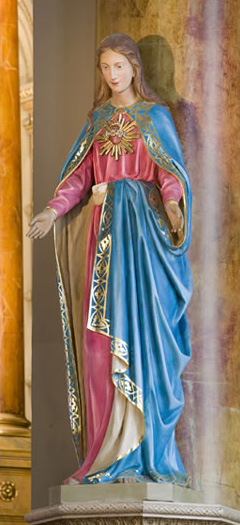Main Altar
When first entering The Shrine, visitors are awestruck by the beautiful golden Main Altar.
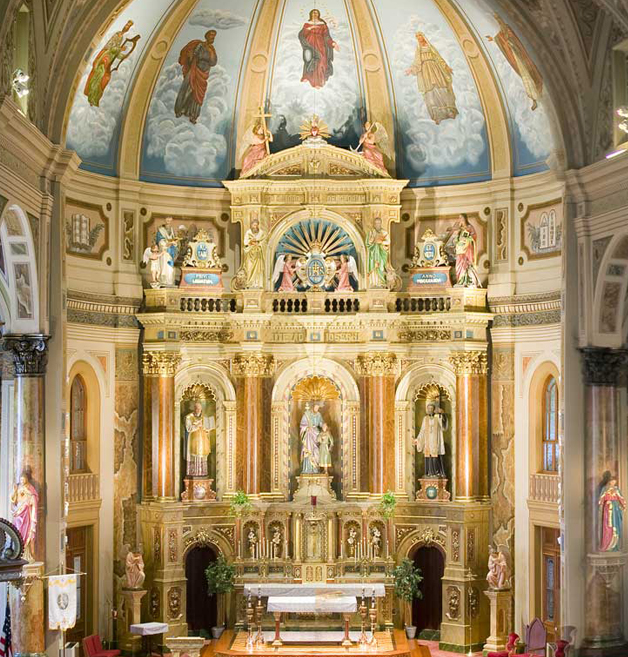
The Main Altar Virtual Tour
The Main Altar
The Main Altar is also known as the "Altar of Answered Prayers". This altar has a wonderful history and was built by thankful parishioners in 1866, who asked for the intercession of St. Joseph in a time of great crisis.
The Colors on the Altar symbolize Christ
White: innocence
Red: love
Green: hope
Blue: loyalty
Gold: total consecration to his Heavenly Father
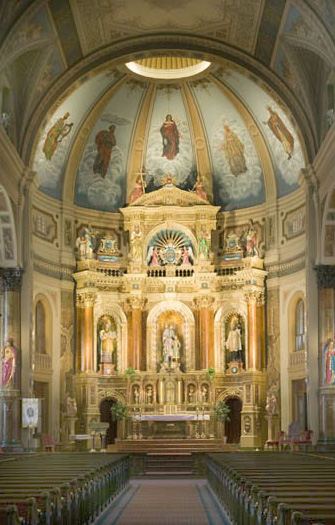
Dome - King David
David is credited with having written most, if not all, of the Psalms. They were always sung.
Many of the Psalms detail David's thoughts and daily concerns. These chapters record a great diversity of emotions, from elation to almost despair and give an insight into the thoughts of one of the great leaders.
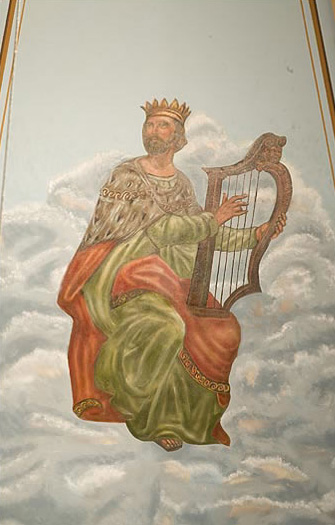
Dome - Abraham
Abraham's original name was Abram meaning either "exalted father" or "(my) father is exalted". For the latter part of his life, he was called Abraham "father of many (nations)".
God promised Abraham that through his offspring, all the nations of the world will come to be blessed.
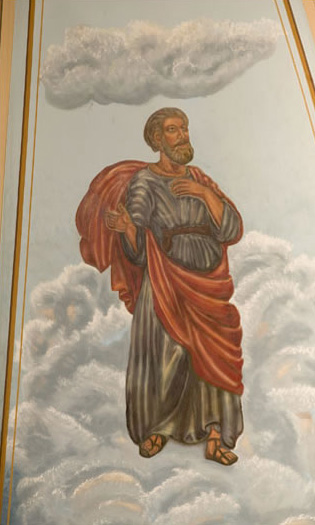
Dome - Assumption of Mary
Catholics believe and teach that Mary was taken body and soul into Heaven.
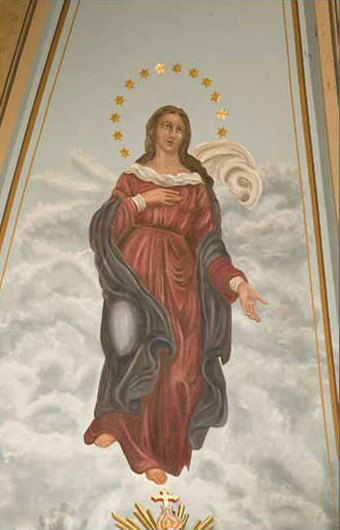
Dome - St. Ann
St. Ann was the wife of Joachim and the mother of the Virgin Mary.
It is assumed that she led the life of a typical Jewish woman of her time.
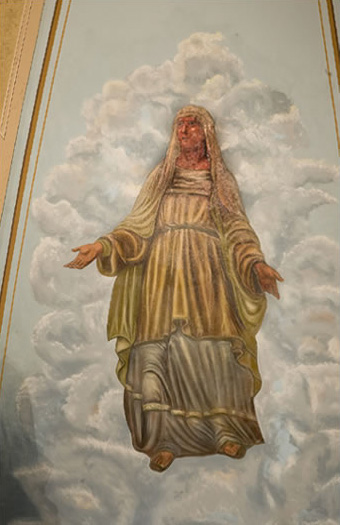
Dome - St. Joachim
St. Joachim was the husband of St. Ann and the father of the Blessed Virgin Mary. He was grandfather of Jesus Christ and was probably wealthy. It is believed that they gave Mary to the service of the Temple when she was three years old.
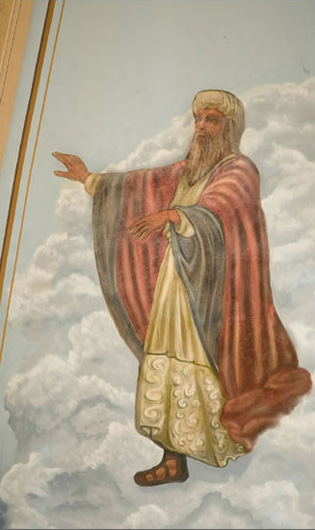
Dome - Main Altar Mural
The painted mural shows from lef to right, King David, Abraham, the Assumption of Mary, St. Ann and St. Joachim.
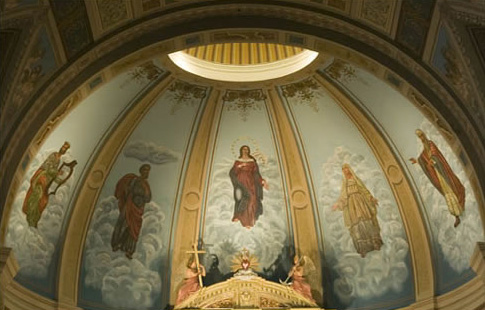
Upper Altar - Top of Altar
On the left: The Angel of Faith holds the cross of salvation
On the right: The Angel of Hope clings to the anchor of hope
In the middle: The Sacred Heart symbolizes the Source of Charity
Ad Majorem Dei Gloriam: "To the Greater Glory of God"
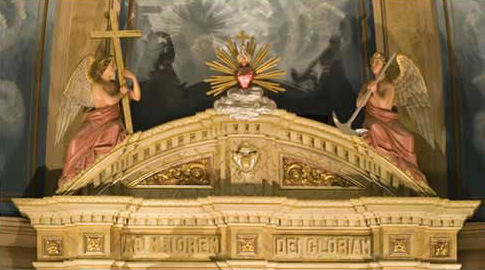
Upper Altar - Upper Section
Below the very top of the altar are statues of the four gospel writers Mathew, Mark, Luke and John. In the center is the Shield of the Holy Name of Jesus which is flanked by two angels. Below are the words in Latin "Ite ad Jospeh" which means "Go to Joseph".
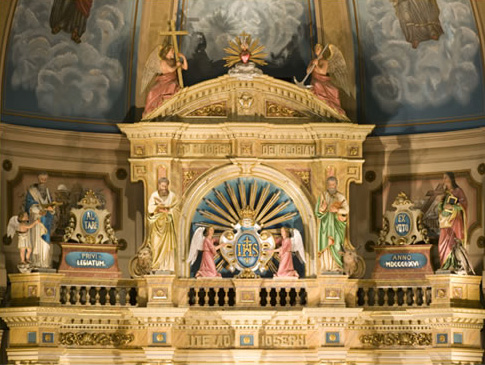
Upper Altar - Shield of Holy Name
The emblem or monogram representing the Holy Name of Jesus consists of the three letters IHS. In the Middle Ages, the name of Jesus was written IHESUS.
The golden rays on the shield represent the blessings and graces we receive through the Holy Name.
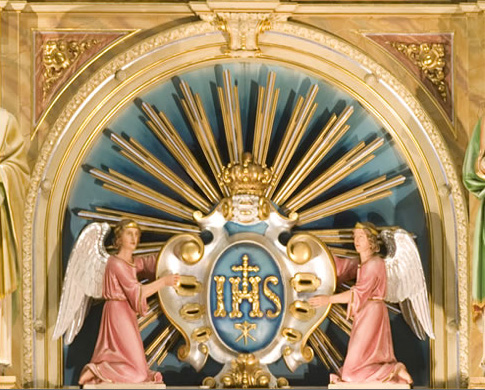
Upper Altar - St. Matthew with Angel
The angel signifies the inspired words written in the first Gospel.
St. Matthew is represented by a divine man because the Gospel highlights Jesus' entry into this world, first by presenting His family lineage - "A family record of Jesus Christ, Son of David, Son of Abraham" - and his incarnaton and birth - "Now this is how the birth of Jesus Christ came about."
St. Matthew's Gospel was written for his fellow countrymen, both believers and nonbelievers. For the nonbelievers, it was designed to convince them that the Messiah had come in the person of Jesus, our Lord, in whom all the promises of the Messianic Kingdom embracing all people had been fulfilled in a spiritual rather than in a carnal way.
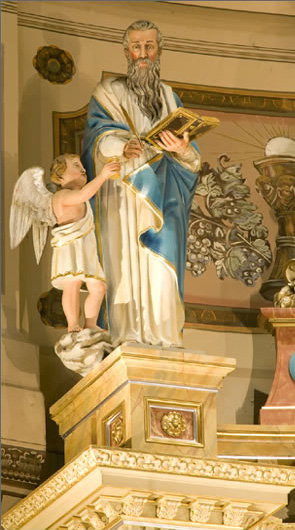
Upper Alter - St. Mark with Lion
St. Mark, represented by the winged lion, references the Prophet Isiah when he begins his gospel: "Here begins the gospel of Jesus Christ, the Son of God." In Isaiah, the prophet, it is written: "I send my messenger before you to prepare your way: a herald's voice in the desert, crying, "Make ready the way of the Lord, clear Him a straight path." "The voice in the dessert crying" reminds one of a lion's roar and the prophetical spirit descending to earth reminds one of a "Winged message." The lion also signified royalty, an appropriate symbol for the Son of God.
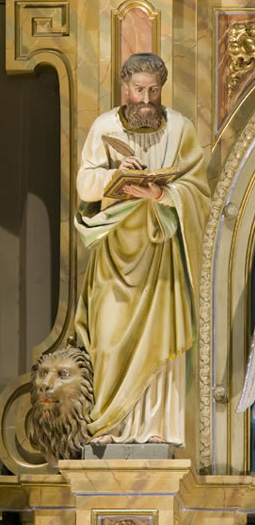
Upper Altar - St. Luke with and Ox
St. Luke is often shown with an ox or a calf because these are the symbols of sacrifice - the sacrifice Jesus made for all the world.
In our day, it would be easy to assume that someone who was a doctor was rich, but scholars have argued that Luke might have been born a slave. It was not uncommon for families to educate slaves in medicine so that they would have a resident family physician.
Luke is the writer of the Gospel and Acts of the Apostles.
Reading Luke's gospel gives a good idea of his character as one who loved the poor, who wanted the door to God's Kingdom opened to all, who respected women, and who saw hope in God's mercy for everyone.
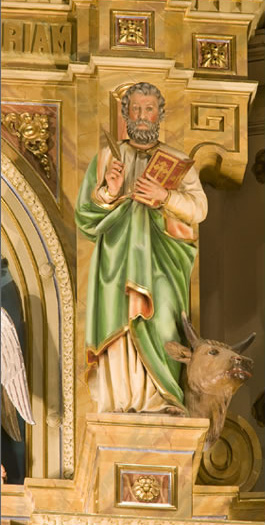
Upper Altar - St. John with an Eagle
St. John is represented by the rising eagle to the throne of God to reveal heaven's mysteries to man.
The Gospel begins with the lofty prologue and rises to pierce most deeply the mysteries of God, the relationship between the Father and the Son, and the incarnation. The Gospel of St. John, unlike the other Gospels, engages the reader with the most profound teachings of our Lord, such as the long discourses Jesus has with Nicodemus and the Samaritan woman, and the beautiful teachings on the Bread of Life and the Good Shepherd. Jesus, too, identified Himself as "the way, the truth, and the life," and anyone who embraces Him as such will rise to everlasting life with him.
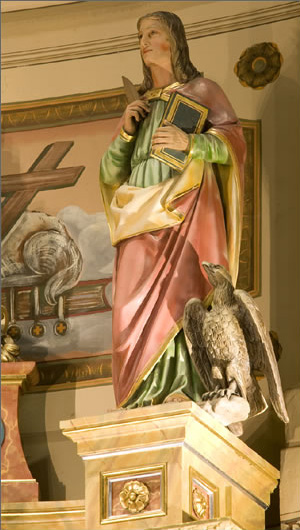
Middle Altar
The middle section of the altar displays three statues. From left to right: St. Ignatius Loyola, the founder of the Jesuits; St. Joseph with the child Jesus; and St. Francis Xavier, one of Ignatius' first followers.
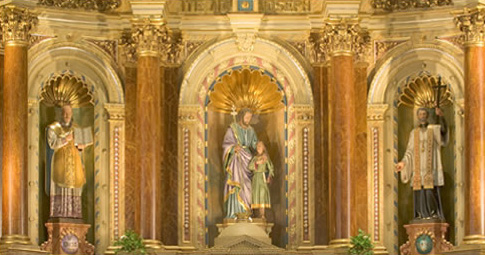
Middle Altar - St. Ignatius Loyola
St. Ignatius was the principal founder of the Society of Jesus in 1534. The members of the Society are called Jesuits. He is famous as the gatherer of the Spriitual Exercises, and known as a talented spiritual director.
His work, the Spiritual Exercises, was written from 1522 - 1524 as is a publication of a simple set of meditations, prayers, and various mental exercises. The exercises of the book were designed to be carried out over a period of 28 - 38 days and strengthen a person's faith experience in Roman Catholic Church manners.
He was canonized on March 12, 1622 and his feast day is July 31st.
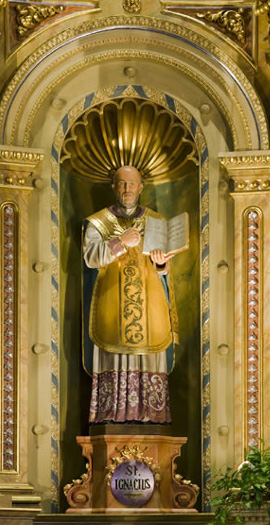
Middle Altar - St. Joseph and the Christ Child
S. Joseph is the Foster Father of Jesus. St. Joseph is strongly exemplified in this striking sculpture, with the child Jesus, during his teaching years.
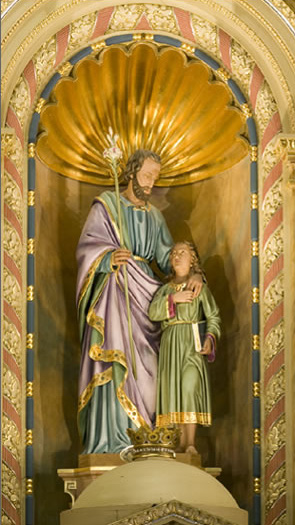
Middle Altar - St. Francix Xavier
St. Francis was one of St. Ignatius' first followers. St. Ignatius asked St. Francis, "What profit a man if he gains the whole world and loses his soul?"
St. Francis is known for his missionary work, both as an organizer and as a pioneer. In India he developed Jesuit missionary methods that became a successful blueprint for his order to follow. He was one of the first Jesuit missionaries to the East Indies and his work is of fundamental significance to the propagation of Christianity in China and Japan.
On November 21st on Shanghuan Island, St. Francis fainted after celebrating Mass. He died on December 3rd at age 46. His incorrupt body was takent to Goa, India and is now in the Basilica of Bom Jesus in Goa.
He was canonized on March 12, 1622 and his feast day is December 3rd.
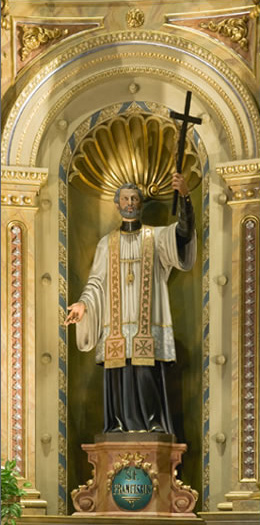
Tabernacle, Altar Table & Lower Altar
This photograph shows the lower area of the Altar. The Tabernacle is in the center with the "Savior on the Cross" insigna. On top of the tabernacle is a Crown.
The golden crwon onthe dome represents Jesus, Christ the King.
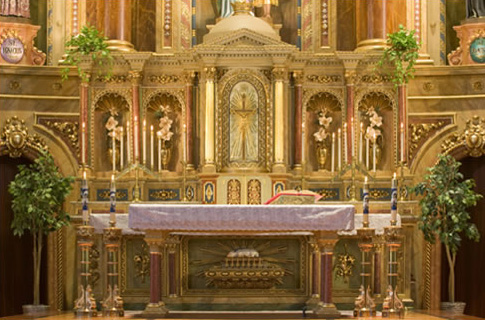
Tabernacle
Close up of Tabernacle.
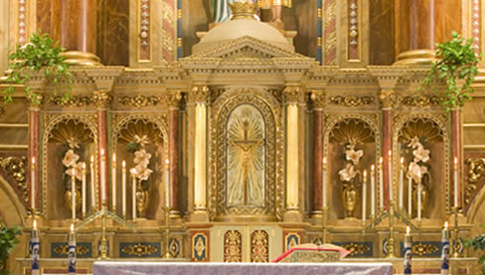
Tabernacle
Close up of Tabernacle.
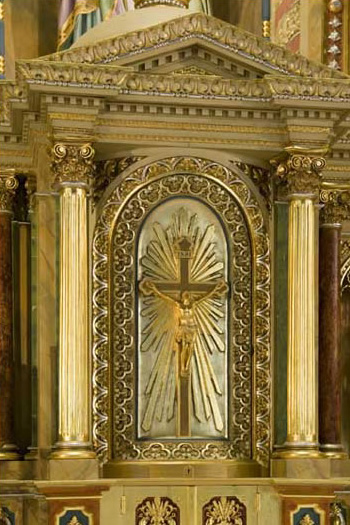
Tabernacle - Lamb of God
The golden rays about the lamb symbolize grace bestowed on us at Mass. Lamb of God is one of the titles given to Jesus in the New Testament. It refers to Jesus' role as sacrificial lamb atoning for the sins of man. This is harkening back to the ancient Jewish Temple sacrifices in which a lamb was slain during the Passover, the blood was sprinkled along the door and the whole lamb was eaten.
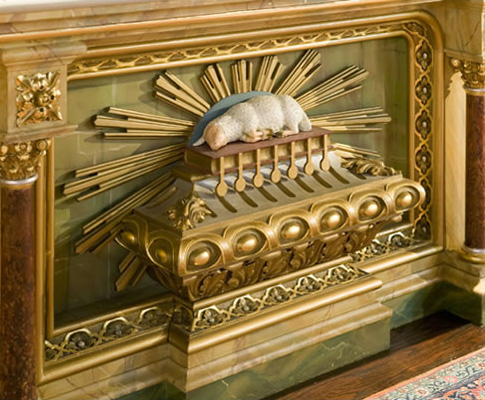
Left Side of Altar - Sacred Heart of Jesus
The Sacred Heart refers to a devotion to Jesus' physical heart as the repesentation of the divine love for humanity. The origin of this devotion in its modern form is derived from a French Catholic nun, Marguerite Marie Alacoque, who said she learned the devotion from Jesus in visions. The Sacredt Heart is often depicted as a flaming heart shining with divine light, pierced by the lance-wound, surrounded by a crown of thorns and bleeding. The wounds and crown of thorns allude to the manner of Jesus' death, while the fire represents the transformative power of love.
The Feast of the Sacred Heart is celebrated 19 days after Pentecost.
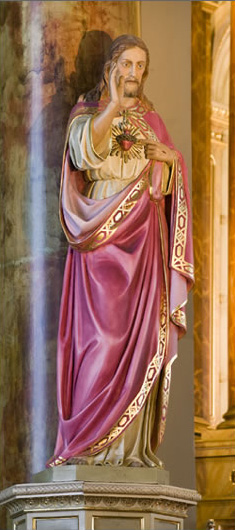
Right Side of Altar - Immaculate Heart of Mary
Immaculate Heart of Mary is a devotional name that refers to the physical heart of Mary, the mother of Jesus, as a symbol of Mary's interior life, her joys and sorrows, her virtues and hidden perfections, and above all her virginal love for her God, her maternal love for her Son, Jesus and her compassionate love for all people.
Traditionally, the heart is pierced with seven wounds or swords in homage to the seven sorrows of Mary.
The Seven Sorrows of Mary
- Prophecy of Simeon over the Infant Jesus
- Flight into Egypt of the Holy Family
- The Loss of the Child Jesus for three days
- The meeting of Jesus and Mary along the Way of the Cross
- Mary watching Jesus suffer and die on the Cross
- Mary recieves the Body of Jesus at the descent from the Cross
- Mary watches as the Body of Jesus is buried in a tomb
